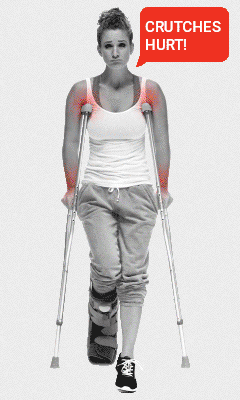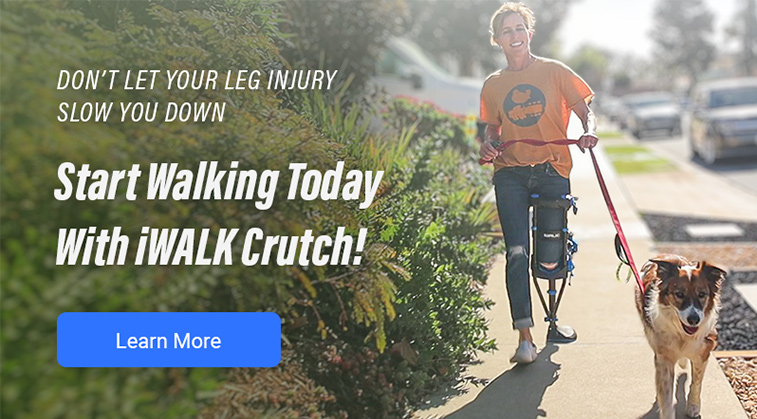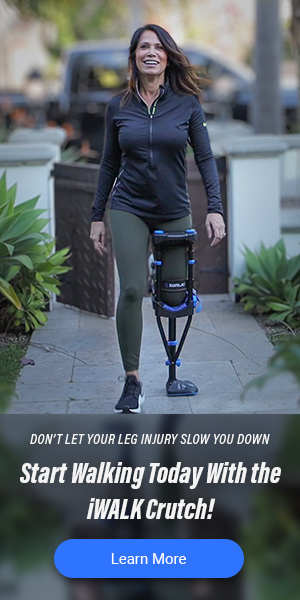Lower Leg Injury Resource Center
Broken Ankle
Diagnosis, Treatment, Surgery & Recovery

Kevin D. Martin, DO, FAAOS
Orthopedic Foot and Ankle Surgeon
Associate Professor of Surgery
About the author – Dr. Martin specializes in orthopaedic surgery of the foot and ankle. In addition to his practice Dr. Martin serves as committee member of the American Orthopaedic Foot and Ankle Society and is a regular contributor to multiple medical journals including Foot and Ankle International.
A broken ankle is one of the most common lower leg injuries. Also called an ankle fracture, it can be a very painful injury and needs to be seen by a medical professional as soon as possible because it may need treatment to heal properly. Walking on a broken ankle can make the injury worse, so if in doubt get it checked out.
The ankle joint is comprised of three different bones, and any one of them can break. Treatment options vary based on the type and severity of the fracture, and recovery typically takes six to 10 weeks.
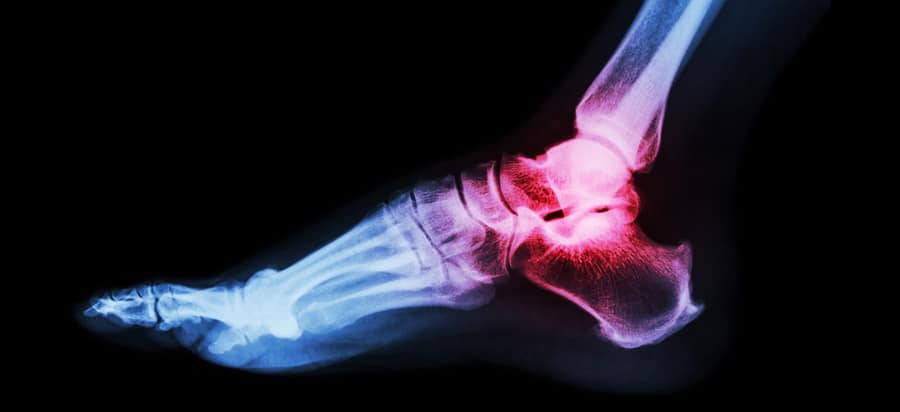
Your Guide To a Broken Ankle Recovery
Ankle Injuries Overview
How Do Broken Ankles Occur?
What Are the Symptoms of a Broken Ankle?
Immediate Care of Your Broken Ankle
How to Diagnose a Broken Ankle
Treatment Options for an Ankle Fracture
How Long Does It Take for a Broken Ankle to Heal?
What Can I Expect During My Broken Ankle Recovery?
Broken Ankle FAQs
I
ANKLE INJURIES OVERVIEW
More than five million ankle injuries occur each year in the United States [1]. They range in severity from sprains (when ligaments give way and tear) to broken ankles. Ankle breaks and ankle fractures are the same thing.
The ankle joint is made up of three bones. The tibia and fibula are the two long bones that extend from your knee to your ankle. The tibia, also known as the shinbone, is the weight-bearing bone and the thicker and larger of the two. The fibula, or calf-bone, runs parallel and helps stabilize the tibia. The third bone in your ankle is the talus, a small wedge-shaped bone at the top of your foot. It supports both the tibia and the fibula.
Any one of these bones can break, but the most common ankle fracture occurs in the lateral malleolus, a part of the fibula just above the ankle joint [2].
If you break a bone, but it remains aligned in the correct position, it is known as a non-displaced ankle fracture. If the fractured parts of the bone have become separated or misaligned, it’s called a displaced ankle fracture.
The Tibia
Commonly known as the shinbone, it is the larger, weight-bearing bone in the lower leg.
The Fibula
The thinner of the two lower leg bones, it runs parallel to the tibia and helps support the larger bone.
The Talus
A small, wedge shaped bone near the top of the foot. It supports both the tibia and the fibula.
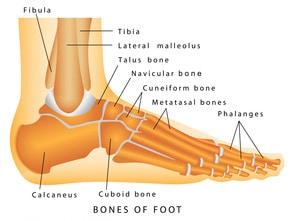
I
HOW DO BROKEN ANKLES OCCUR?
How Does Sprained or Broken Ankle Occur?
Broken ankles are a common injury and usually caused by sudden trauma. This could be anything from a simple fall on an icy sidewalk to a sporting injury or car accident. Common things that can cause fractured ankles include:
- Twisting, rotating or rolling your ankle
- A slip or trip that causes you to land on your ankle
- An impact from a motor vehicle accident
- Jumping or falling from height and coming straight down on your ankle
- Dropping something heavy on your ankle.

A study of nearly 10,000 patients with ankle fractures [3] found that the two most common causes of injury were falls (61 percent) and sports (22 percent). Years with colder winters saw more cases, and the risk was slightly higher for women than for men. Additionally, most ankle fractures occur in two distinct groups: young adults active in sports and high impact activities, and elderly people due to trip-and-fall injuries.
I
WHAT ARE THE SYMPTOMS OF A BROKEN ANKLE?
The most common symptom of a broken ankle is pain, which is usually immediate and intense. The pain may radiate up and down your leg and into your foot. You may also experience some or all of the following symptoms.
- Swelling at the ankle joint
- Bruising, redness, or discoloration of any part of your lower leg
- Being unable to put any weight on your injured ankle or foot
- Tenderness
- Feeling dizzy due to pain
- Your foot may hang in an unusual position or look out of place
- In some cases, you may see exposed bone, which is called an open or compound fracture.
Occasionally a small ankle break may not feel very painful. Many people assume that if you can walk on an injury it’s not broken, but this isn’t always the case. If you continue to walk on a broken ankle it can easily develop into a major break, so it’s imperative that you have a doctor examine your ankle if you have any symptoms. If you can’t see your own doctor quickly you may need to go to an emergency room or, if symptoms are severe and you can’t get to a hospital on your own, call an ambulance.
I
IMMEDIATE CARE OF YOUR BROKEN ANKLE
Try not to put any weight on your injured leg while you’re waiting to see a doctor. Keep it elevated by propping it up with cushions or clothes to help control the swelling. If your skin isn’t broken, you could try wrapping it with a compression bandage or kitchen towel and applying an ice pack or bag of frozen peas for 15 to 20 minutes every couple of hours. It’s essential not to wrap it too tightly, however, because doing so can cause further complications. Remember not to apply ice directly to your bare skin, and do not apply ice if the skin is broken.
If you can see a bone protruding through the skin, don’t try to push it back in place. Cover it with a clean dressing, cloth or towel and seek medical attention immediately. It’s best not to eat or drink anything until you’ve seen a doctor in case you need surgery.
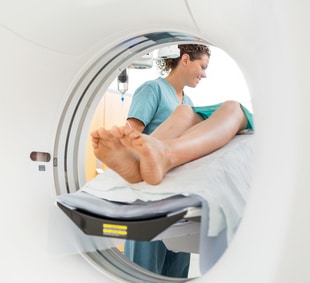
I
HOW TO DIAGNOSE A BROKEN ANKLE
The only way to determine whether or not you have a broken ankle is to see a doctor. They’ll ask about your symptoms and how you injured your ankle, as well as gather details about your medical history. They’ll examine your ankle, and if they suspect it’s broken will order imaging tests to see the bones in more detail.
X-ray
The most commonly used imaging technique, X-rays can diagnose most ankle fractures. They will also determine the severity of the ankle fracture and whether there are additional fractures in your leg or foot.
CT Scan
Computed tomography (CT) scans produce a cross-sectional image of the ankle, ankle joint, and leg quickly and painlessly. A CT scan shows both hard and soft tissues. This makes it very helpful in diagnosing ankle fractures, cartilage injuries and dislocations.
MRI
Magnetic resonance imaging (MRI) scans are very good at diagnosing ligament injuries, sprains and stress fractures. MRIs are not typically performed for ankle fractures but may be part of a more detailed examination by an Orthopedic surgeon.
Questions to Ask About Your Broken Ankle
Receiving a broken ankle diagnosis can be a stressful experience, so here’s a quick list of questions you may want to ask your doctor to begin charting your course toward recovery:
- Do I have to have surgery and what are the risks?
- How long before I can go back to work?
- Will any of my lifestyle or medical conditions put me at risk for longer healing time?
- When will I be able to start walking on my leg again?
- How long before I can get back to my regular activities?
- When can I return to sports or high impact activities?
I
TREATMENT OPTIONS FOR AN ANKLE FRACTURE
Your treatment plan will depend on the type, location and severity of your ankle fracture. You’ll probably need to wear a cast, splint or walking boot for six to 10 weeks to keep your bones in place while they heal. During this time, you’ll be non-weight bearing, which means you can’t put any weight on your injured leg at all. You’ll need to use a mobility device like crutches, a knee scooter, or a hands-free crutch to make this phase of your recovery as seamless and successful as possible.
If you have a serious ankle break, you may need surgery. This is usually because the bone is broken in more than one place or has moved out of position. Your doctor will probably want to operate as soon as possible, but if you have a lot of swelling, they may decide to put your leg in a splint for a few days and wait for the swelling to subside.
The most common surgery for a broken ankle is open reduction and internal fixation (ORIF), which uses metal rods, plates and screws to realign your bone or bones. The hardware is generally left in place even after your ankle has healed and is only removed if it causes problems. This type of surgery is usually performed under general anesthetic.
I
HOW LONG DOES IT TAKE FOR A BROKEN ANKLE TO HEAL?
Recovery time for a broken ankle is between six and 10 weeks. Whether you have surgery or not, you’ll probably need to wear a cast, splint or walking boot for about the first six weeks. Once your doctor has given you the go-ahead, you can start putting some pressure on your foot and slowly build up to walking again over a few weeks. You’ll wear a walking boot to help support you while you take your first steps.
Once your broken ankle has healed, it’s important to frequently work on moving your ankle in all directions. This helps prevent stiffness and contracture, a tightening of muscles and tendons that causes a joint to shorten and become very stiff. You may continue to experience some swelling for up to a year afterward, and your doctor will tell you when it’s okay to return to sports or high-impact activities.
I
WHAT CAN I EXPECT DURING MY BROKEN ANKLE RECOVERY?
Being off your feet for weeks can be frustrating, but this period of non-weight bearing activity is a crucial part of the recovery process. Walking on a broken ankle too early can prevent it from healing correctly and may make the injury worse. Fortunately, there are a few different mobility devices that can help you to stay mobile during this challenging phase.
Traditional Crutches
Traditional crutches are easy to get a hold of and relatively inexpensive. Many people use crutches after ankle surgery or while recovering from an ankle fracture. However, they are tiring to use and can cause pain in other parts of your body, particularly your arms and hands. Traditional crutches are also restrictive because they require the focused effort of your hands and arms. This means you can’t carry anything. Because of these limitations, people are often tempted to walk on a broken ankle too soon, causing further problems.
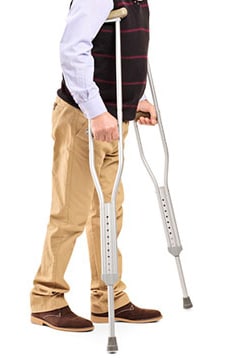
Knee Scooters or Knee Walkers
Knee scooters, also called knee walkers, are another option to stay mobile while recovering from a broken ankle. They are more efficient than crutches and require less upper body strength. Knee scooters are great on flat surfaces and enable you to scoot easily from point A to point B without getting exhausted, but they don’t work on stairs, slopes or uneven terrain. You also need to use your hands to operate a knee scooter, so you still can’t carry things. They are also bulky, which makes them challenging to transport. It’s also difficult to navigate tight environments using a knee scooter.
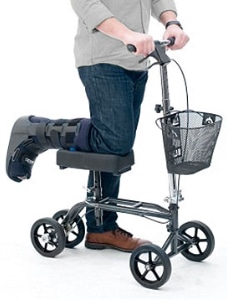
iWALK Hands-Free Crutch
The iWALK hands-free crutch enables you to walk unaided with full use of your hands and arms. It functions like a temporary lower leg so you can go about your daily life as usual while recovering from a broken ankle. It can be used on stairs, slopes, uneven terrain and in the shower. A 2019 medical study [4] found that nine out of 10 patients prefer the iWALK crutch to traditional crutches.
Moreover, studies show the iWALK simulates normal walking in a way that engages upper and lower leg muscles while immobilizing the foot. Research proves that muscle activity boosts blood flow, and that speeds recovery times. Engaging lower leg muscles while using the iWALK also may mitigate muscle atrophy, which is unavoidable using traditional crutches or knee scooters.
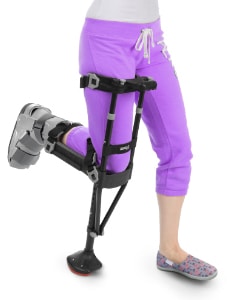
I
BROKEN ANKLE RECOVERY TIPS
Remember to rest and elevate your ankle whenever possible during your recovery. Gently move your toes and bend your knee regularly to prevent your muscles from getting stiff. As tempting as it is, try not to put anything down your cast to scratch an itch. It may get stuck or cause damage to your skin, increasing the risk of infection.
It’s also important that you don’t get your cast wet, so you’ll need to use a special protective cover when you shower or bathe. Some people use a plastic bag wrapped tightly around the cast, although it’s not as reliable. In the shower, balance your injured leg on a stool or use a hands-free crutch like the iWALK.
Over the counter painkillers such as acetaminophen (e.g. Tylenol) or ibuprofen (e.g. Advil, Motrin IB) can help with discomfort during the early stages of recovery, but if you’re in a lot of pain, your doctor may prescribe a stronger medication. Before starting any medication, talk to your doctor to ensure they are safe for your unique medical needs.
I
BROKEN ANKLE FAQ
How long does it take to heal a broken ankle?
It takes around six to 10 weeks to recover from a broken ankle. During this time, you will probably need to wear a cast or boot. Most people are able to walk normally again and resume their daily activities by around three months. Endurance will improve over time and as your strength improves. Your doctor will tell you when it’s okay to return to sports or other high-impact activities.
How long do you have to wear a boot for a broken ankle?
You’ll probably wear a cast or walking boot for around six to10 weeks after an ankle break or fracture. After this, you’ll probably continue to wear a boot for another few weeks to support your ankle as you start to weight your injured ankle again.
When can you put weight on a broken ankle?
Your doctor will tell you when it’s okay to put weight on your broken ankle. For most people, it’s after about two to six weeks although it may be less or more depending on the type and severity of your fracture. It’s crucial to adhere to your doctor’s orders not to put any weight on your leg too early as walking on a broken ankle too early can prevent it from healing.
How long after a broken ankle can I walk?
Most people get the green light to slowly start putting weight on their leg around six weeks after breaking their ankle. The amount of time may be less or more depending on the severity of your injury, and it can take a few more weeks more before you’re walking normally again. It generally takes six to 10 weeks for a broken ankle to heal. Conditions like diabetes and nicotine use can slow the healing time significantly, potentially even doubling the amount of time it takes to heal from a broken ankle.
Can you fully recover from a broken ankle?
You should be able to resume your normal daily routine around three months after breaking your ankle. It can take several months to regain strength and range of motion in your ankle.
Will I need crutches after ankle surgery?
You’ll probably need to keep weight off your broken ankle for at least six weeks. Most people use crutches after ankle surgery but other mobility devices to consider include knee scooters and the iWALK hands-free crutch.
The information above is intended for informational purposes only and is not intended to prevent, treat, or diagnose any illness or disease. We aim to provide the highest quality information, so if you have any questions on the information above, we welcome your feedback!
I
RESOURCES
- Scott M Koehler, MD, Patrice Eiff, MD. Overview of ankle fractures in adults. 31 October 2019. UpToDate. https://www.uptodate.com/contents/overview-of-ankle-fractures-in-adults
- Elsoe R, Ostgaard SE, Larsen P. Population-based epidemiology of 9767 ankle fractures. Foot Ankle Surg. 18 November 2016. https://pubmed.ncbi.nlm.nih.gov/29413771/
- Elsoe R, Ostgaard SE, Larsen P. Population-based epidemiology of 9767 ankle fractures. Foot Ankle Surg. 18 November 2016. https://pubmed.ncbi.nlm.nih.gov/29413771/
- Kevin D. Martin, DO, Alicia M. Unangst, DO, Jeannie Huh, MD, Jamie Chisholm, MBA. Patient Preference and Physical Demand for Hands-Free Single Crutch vs Standard Axillary Crutches in Foot and Ankle Patients. Foot Ankle Int. 2 August 2019. https://pubmed.ncbi.nlm.nih.gov/31375043/

